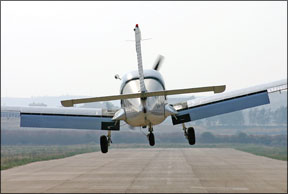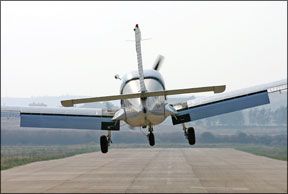Its probably a fair bet that every person who has flown an airplane more than about 20 hours has made at least five landings he or she not only considers personally embarrassing but remains convinced to this day could be measured on the Richter scale. So, lets be honest with ourselves from the very beginning: As active pilots, we are going to make ugly landings from time to time. Further, Murphys Law says we will probably make them when a lot of people are watching. Therefore, lets recognize that a little humility (and perhaps humiliation) is the price Jorge Santos 288 of acquiring and maintaining the skills necessary to cause a rapidly moving flying machine to return to the planet in a condition to be reused immediately. As a result, once we firmly accept that from time to time were going to make runway arrivals of the sort to make cement contractors rub their hands in financial glee, we are going to be less likely to try to force the airplane onto the ground due to embarrassment after we have bounced telephone pole high, and more likely to think rationally about the attitude, speed and altitude of the airplane and proceed to coolly evaluate whether to try to salvage the landing or go around. Bad Landing Factors Blowing a landing is generally defined as a pretty serious bounce, usually coupled with allowing the airplane to drift off the runway centerline. As the airplane yaws, it is no longer pointed in the direction it is traveling. This is not a time for sudden, major control inputs, as the John Wayne approach to flying almost always makes matters worse. Appropriate action is usually making the decision to abandon the landing attempt, applying full power, establishing the normal climb attitude for the flap setting, carrying out a go around, and then collecting ones thoughts while flying the pattern and setting up another approach, this time on speed. Even a cursory look at NTSB accident data makes it clear that trying to salvage a “blown” landing by continuing with the landing has a far lower rate of success just going around. Are there any generalizations that may be made about landing accidents out of “blown” or bounced landings? Funny you should ask: There are two factors showing up in the accident data consistently. First, a significant percentage of the accident pilots are low-time-in-type, have not flown much recently and/or havent had recent recurrent training. The common factor is that they are not truly comfortable and in tune with the degree of responsiveness of the controls of the airplane being flown. The second factor is most accidents also involve carrying too much speed on final. Once the factors join up, they are then followed either by the pilot misjudging the flare and ballooning upward where speed and directional control deteriorate, or misjudging the flare and touching down hard in a level or nosewheel-first attitude. This often causes the pilot to exacerbate the bounce by flinching and pulling the yoke aft to balloon the airplane upward where speed and directional control deteriorate. After that point, pilots tend to get creative in the ways they do bad things to airplanes. They may shove forward on the yoke in response to ballooning, thus driving the airplane back to the runway, often onto the nosewheel. The pilots natural reaction is to again haul back on the yoke, inducing a yo-yo effect in pitch known politely as pilot induced oscillation (PIO) (and colloquially as “Aww $#^*, I broke the nosewheel and bent the firewall,” because thats what usually happens next). Another popular scenario is where the pilot initially does nothing as the airplane balloons and the speed dissipates, but then as the inevitable sink begins, hauls the yoke all the way aft in a vain effort to arrest the descent. Depending on the height of the bounce and how things were handled, that one is usually just embarrassing: The airplane runs out of energy for doing not much more than just hitting hard. Fortunately, the landing gear, especially on trainers, is built to take a fair amount of abuse. However, if a crosswind is added to the equation, the pilots inaction may mean directional excursions leading to a less-than-desirable conclusion. A third, and sadly common alternative, is the pilot simply becomes a passenger, doing nothing at all, and lets the airplane go where it will. Depending on wind, luck and perhaps the phase of the moon, the results can be anything from a surprisingly smooth touchdown to complete loss of control including dragging a wingtip and high speed departure from the runway into further unpleasantness. What We Can Do? There are a number of guidelines for avoiding a botched landing and, if those fail, steps to take to recover from one with a minimum of excitement. 1. Keep flying the airplane. No matter what happens on the landing, from a grease job to a horrendous bounce that leads to the airplane careening off the runway toward something large, hard and expensive, keep doing your utmost to make the airplane go where you want it to go. 2. When new to any airplane, spend some time at altitude doing slow flight to get a good feel for the responsiveness, or lack thereof, in pitch. What may be normal pitch inputs on final and in the flare in a Cessna 172 or Cherokee Warrior may make a Grumman Tiger describe a sine wave because it is far more responsive in pitch at landing speeds. Recognize that you are at increased risk for a landing accident for your first 40 or 50 hours in any airplane, if you are not flying regularly and/or not taking regular recurrent training; so approach landings conservatively as to the length of runway youll use and the amount of crosswind youll accept until you know what the airplane will and wont do. 3. Fly the approach on-speed. Fly at the published approach speed, usually 1.3 Vso and no more. Extra speed on the approach is an invitation to a landing accident. It also is a cause of the overshoot accidents where pilots force the airplane onto the ground, in level attitude, and then run off the end of the runway. 4. It is simplistic but true, on any runway shorter than 4000 feet, if you have not touched down in the first third of the runway, go around. Fly the go around by applying full power, establishing normal climb attitude, retracting the flaps appropriately for the airplane and using the controls to fly the airplane so that it stays over the runway. 5. Burn into your consciousness what instructors think is important when teaching landings: that directional control is far more important than a smooth touchdown. Maintaining directional control of the airplane throughout the landing (and botched landing recovery) is paramount, especially in a crosswind. Instructors are very willing to put up with a firm arrival. What scares instructors, and has them take the airplane away from the student, is when the student doesnt keep it under control directionally, that is, pointed down the runway parallel to the centerline and corrected for drift. 6. Until you have 40 or 50 hours in the airplane and are truly comfortable with the pitch control response, if you bounce or balloon, do not move the control yoke/stick forward. At all. Its better to hold what you have, so to speak, to keep the yoke where it is; dont push it forward. Once you have let the bounce or balloon start to play itself out you may be able to flare once again, however, the vast majority of the time you can hold the yoke where it is because the airplane will usually be at least slightly nose high, which is a good thing and then, once the airplane starts to sink, keep it in landing attitude and add some power to cushion the descent to touchdown. Moving the yoke forward is an excellent way to start PIO, so as a general rule, dont do it. Hold it steady and control the descent with power-experience will tell you how much power-initially youll be surprised that it doesnt take much. 7. Be constantly aware of the wind direction. If you bounce and/or balloon, keep the upwind wing down into the wind. If there is a crosswind and you touched down with one wing low to correct for drift, keep that wing down at least slightly. Letting the upwind wing get above the horizontal radically increases your chances of losing control. You had corrected the drift, keep doing it and keep the aileron into the wind once you are back on the ground. 8. After the second bounce, go around. Write it off. If you bounce twice things are not coming together and the odds are starting to seriously stack up against you. NASA research shows that there is a very powerful psychological drive to complete a landing once started, no matter how badly it is going-that urge has to be overcome. Therefore, so long as you havent used so much of the runway that you cant go around and clear obstructions, you are better off making the judgment call to put the landing attempt behind you and go around. The real pilots watching you will silently salute your good judgment in going around. As a student pilot, I took five tries to land a Piper J-3 in a crosswind on one of my student solo cross-countries. I was mortified. After I got my logbook signed, a pilot came up to me and told me that going around was the smartest thing hed seen anyone do on the airport that day. Had I tried to force the airplane to land during one of my bounced attempts, I would probably have wrecked it. A go-around is a sign that a pilot has excellent judgment. 9. Be willing to put the controls to the stops to get the airplane to go where you desire. While we just called for caution with the elevator, recovery from a blown landing, especially in a crosswind, may require that the rudder and/or ailerons be put all the way to the stop to accomplish what you want. When a pilot lets an airplane drift off the runway during a botched landing, the primary reason was not the strength of the wind, it was that the pilot did not use all of the control available. Airplanes certified after about 1940 have more than adequate control authority to handle just about any blown landing situation so long as they are within the demonstrated crosswind component. 10. When making a go around, keep the airplane over the runway. Just because you were smart enough to initiate a go around doesnt mean you can let the airplane keep going where it was pointed when you made that decision. Correct for wind drift, make turns as necessary to get back over the runway and then keep the airplane climbing out over the runway where it wont hit anything. Until flying is completely automated, and probably even then, there are going to be blown landings. The solution is always going to be a thinking pilot who continues to fly the airplane and makes the decision to either place it into a slightly nose up attitude, with appropriate wing down into the wind to control drift and then uses power as needed to control the descent for the subsequent touchdown or to apply full power and go around. Rick Durden is a practicing aviation attorney and type-rated ATP/CFI with more than 6500 hours.




